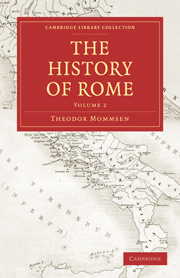Book contents
- Frontmatter
- Contents
- MAP OF ITALY
- BOOK THIRD: FROM THE UNION OF ITALY TO THE SUBJUGATION OF CARTHAGE AND OF THE GREEK STATES
- CHAPTER I CARTHAGE
- CHAPTER II THE WAR BETWEEN ROME AND CARTHAGE CONCERNING SICILY
- CHAPTER III THE EXTENSION OF ITALY TO ITS NATURAL BOUNDARIES
- CHAPTER IV HAMILCAR AND HANNIBAL
- CHAPTER V THE WAR UNDER HANNIBAL TO THE BATTLE OF CANNÆ
- CHAPTER VI THE WAR UNDER HANNIBAL FROM CANNÆ TO ZAMA
- CHAPTER VII THE WEST FROM THE PEACE OF HANNIBAL TO THE CLOSE OF THE THIRD PERIOD
- CHAPTER VIII THE EASTERN NATIONS AND THE SECOND MACEDONIAN WAR
- CHAPTER IX THE WAR WITH ANTIOCHUS OF ASIA
- CHAPTER X THE THIRD MACEDONIAN WAR
- CHAPTER XI THE GOVERNMENT AND THE GOVERNED
- CHAPTER XII THE MANAGEMENT OF LAND AND OF CAPITAL
- CHAPTER XIII FAITH AND MANNERS
- CHAPTER XIV LITERATURE AND ART
- CORRECTIONS
CHAPTER III - THE EXTENSION OF ITALY TO ITS NATURAL BOUNDARIES
Published online by Cambridge University Press: 05 October 2010
- Frontmatter
- Contents
- MAP OF ITALY
- BOOK THIRD: FROM THE UNION OF ITALY TO THE SUBJUGATION OF CARTHAGE AND OF THE GREEK STATES
- CHAPTER I CARTHAGE
- CHAPTER II THE WAR BETWEEN ROME AND CARTHAGE CONCERNING SICILY
- CHAPTER III THE EXTENSION OF ITALY TO ITS NATURAL BOUNDARIES
- CHAPTER IV HAMILCAR AND HANNIBAL
- CHAPTER V THE WAR UNDER HANNIBAL TO THE BATTLE OF CANNÆ
- CHAPTER VI THE WAR UNDER HANNIBAL FROM CANNÆ TO ZAMA
- CHAPTER VII THE WEST FROM THE PEACE OF HANNIBAL TO THE CLOSE OF THE THIRD PERIOD
- CHAPTER VIII THE EASTERN NATIONS AND THE SECOND MACEDONIAN WAR
- CHAPTER IX THE WAR WITH ANTIOCHUS OF ASIA
- CHAPTER X THE THIRD MACEDONIAN WAR
- CHAPTER XI THE GOVERNMENT AND THE GOVERNED
- CHAPTER XII THE MANAGEMENT OF LAND AND OF CAPITAL
- CHAPTER XIII FAITH AND MANNERS
- CHAPTER XIV LITERATURE AND ART
- CORRECTIONS
Summary
Natural boundaries of Italy
The Italian confederacy as it emerged from the crises of the fifth century—or, in other words, the State of Italy—united the various civic and cantonal communities from the Apennines to the Ionian Sea under the hegemony of Rome. But before the close of the fifth century these limits were already overpassed in both directions, and Italian communities belonging to the confederacy had sprung up beyond the Apennines and beyond the sea. In the north the republic, in revenge for ancient and recent wrongs, had already in 471 annihilated the Celtic Senones; in the south, through the great war from 490 to 513, it had dislodged the Phœnicians from the island of Sicily. In the north there belonged to the combination headed by Rome the Latin town of Ariminum (besides the burgess-settlement of Sena), in the south the community of the Mamertines in Messana, and as both were nationally of Italian origin, so both shared in the common rights and obligations of the Italian confederacy. It was probably the pressure of events at the moment rather than any comprehensive political calculation, that gave rise to these extensions of the confederacy; but it was natural that now at least, after the great successes achieved against Garthage, new and wider views of policy should dawn upon the Roman government—views which even otherwise were obviously enough suggested by the physical features of the peninsula.
- Type
- Chapter
- Information
- The History of Rome , pp. 62 - 83Publisher: Cambridge University PressPrint publication year: 2010First published in: 1862



